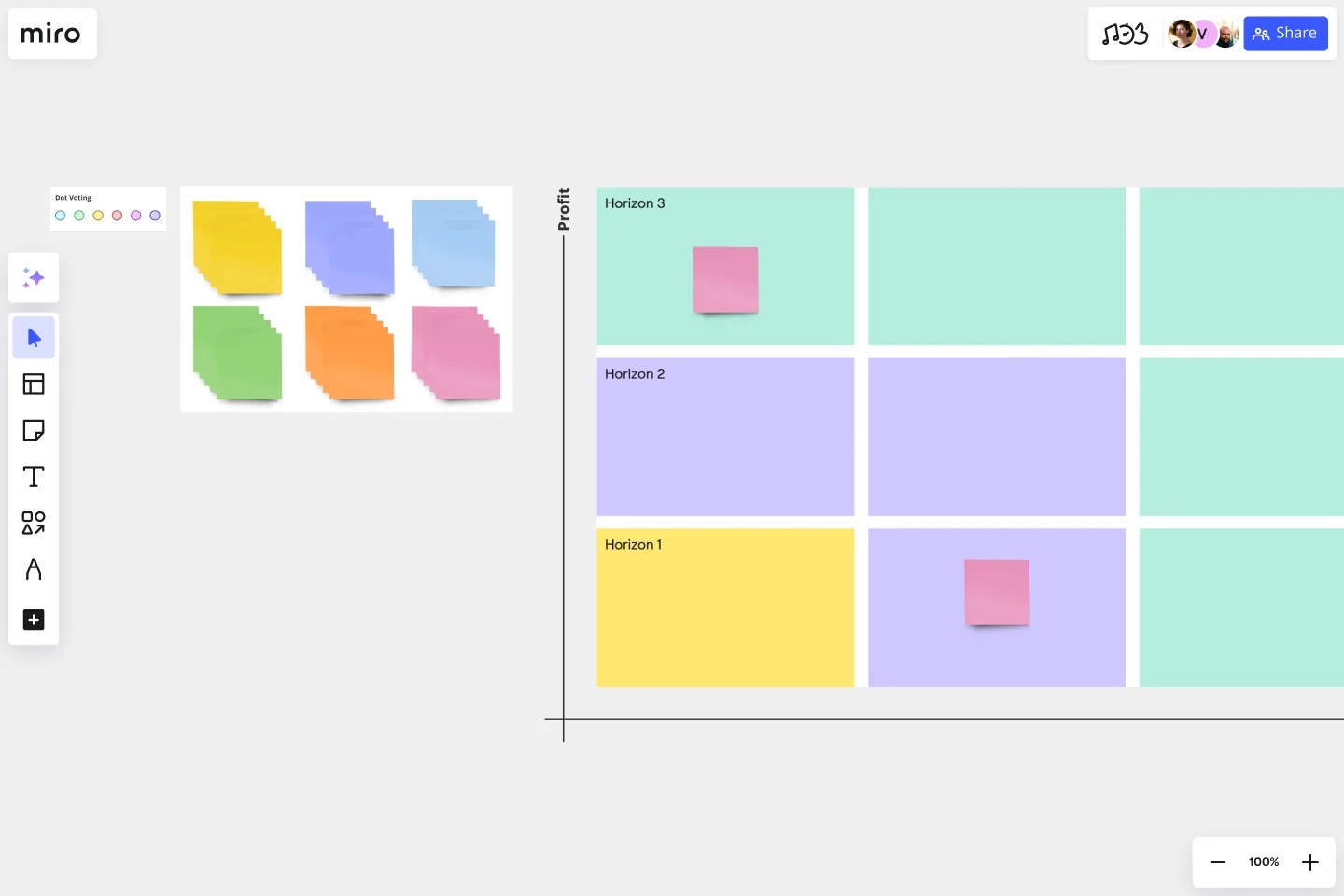3 Horizons of Growth Template
Concurrently manage current and future opportunities for growth.
About the 3 Horizons of Growth template
What is the 3 Horizons of Growth model?
As companies grow, it can be difficult to keep innovating at the same pace. Innovation is often discarded in favor of inertia. To keep up their momentum, organizations have to balance their existing business with potential growth opportunities. That’s where the 3 Horizons framework comes in.
First introduced in The Alchemy of Growth, the 3 Horizons of Growth model helps companies assess potential growth opportunities while finding ways to maintain existing business. C-suite leaders use the 3 Horizons model as a blueprint for investing in current products and services while looking to the future. But its use is not confined to the C-suite. Teams across the organization can make use of the 3 Horizons model to ensure their projects map to the organization’s goals.
What are the 3 Horizons?
The 3 Horizons represent current opportunities, future opportunities that require substantial investment, and ideas for future opportunities that can be used as experiments, pilots, or minority stakes in new businesses.
How do you use the 3 Horizons of Growth template?
Use the 3 Horizons of Growth template when you want to strategically think about your business currently and in the future. The x-axis represents time, but keep in mind that it’s not an indication of what you should be thinking about now vs. later. You should be thinking about all three horizons at the same time. You will always want to cycle between where your business is strong now, which opportunities you believe will be successful in the future, and which opportunities you’d like to explore further.
What are the benefits of the Horizons of Growth model?
Benefit 1 - Take stock of current opportunities. To start, the Horizons of Growth model requires you to make a note of all current opportunities. This exercise helps frame the rest of the model and ensure you’re aligned with your team.
Benefit 2 - Identify future opportunities for investment. The Horizons model empowers you to pinpoint opportunities to maximize cash flow. Use the model to brainstorm with your team and come up with ideas for quick wins.
Benefit 3 - Experiment and iterate. Many C-suite execs use the Horizons of Growth model to find potential areas for experimentation. Those might include research projects, pilot programs, or minority stakes in new business.
When to use the 3 Horizons of Growth model
1. To foster a culture of innovation
2. To create a framework necessary for achieving long-term initiatives
3. To identify opportunities for new business
4. To enhance business analysis and focus on potential challenges
5. To prepare a developmental plan
Get started with this template right now.
Product Backlog Template
Works best for:
Agile Methodology, Kanban Boards, Product Management
Development teams are often juggling many products at once. A product backlog is a project management tool that helps teams keep track of projects in flight as they build and iterate, so you can store everyone's ideas, plan epics, and prioritize tasks. The highest-priority tasks are at the top of the product backlog, so your team knows what to work on first. Product backlogs make it easier for teams to plan and allocate resources, but it also provides a single source of truth for everyone to know what development teams are working on.
Weekly Planner by Elina Schäfer
Weekly Planner template is perfect for organizing your weekly tasks and schedules. It helps you prioritize activities, set deadlines, and manage your time effectively, ensuring you stay productive and on track throughout the week.
Fishbone Diagram for Marketing
Works best for:
Fishbone Diagram
Optimizing marketing strategies requires identifying underlying issues. The Fishbone Diagram Marketing template helps you systematically explore factors affecting your campaigns. Categorize potential causes into areas such as market research, product positioning, promotional strategies, and distribution channels. This structured analysis enables your team to pinpoint and address issues, enhancing marketing effectiveness and achieving better results.
Service Blueprint by Hyperact
Works best for:
Research & Design
The Service Blueprint template is perfect for visualizing the orchestration of service components. It maps out frontstage and backstage elements, helping you analyze and enhance customer experiences. Use this template to align teams, identify pain points, and streamline processes, ensuring a seamless service delivery. It's ideal for creating a shared understanding of service dynamics among stakeholders and collaborators.
Ansoff Matrix Template
Works best for:
Leadership, Operations, Strategic Planning
Keep growing. Keep scaling. Keep finding those new opportunities in new markets—and creative new ways to reach customers there. Sound like your approach? Then this template might be a great fit. An Ansoff Matrix (aka, a product or market expansion grid) is broken into four potential growth strategies: Market Penetration, Market Development, Product Development, and Diversification. When you go through each section with your team, you’ll get a clear view of your options going forward and the potential risks and rewards of each.
Ecomap Template
Works best for:
Strategy & Planning, Diagramming
The Ecomap Template illustrates the multifaceted relationships and environmental interactions encircling an individual or entity. Determine crucial patterns and dynamics by providing a clear and comprehensive visualization of how different systems intertwine and influence each other.
